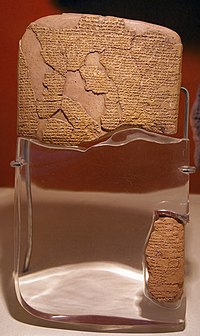Egyptian–Hittite peace treaty

The Hittite version (above, at the Istanbul Archaeology Museums) and Egyptian (below, at the Precinct of Amun-Re in Karnak)
|
|
 |
|
| Created | c.1259 BC |
|---|---|
| Discovered | 1828 (Egyptian) and 1906 (Hittite) |
| Present location | Istanbul Archaeology Museums and Precinct of Amun-Re in Karnak |
The Egyptian–Hittite peace treaty, also known as the Eternal Treaty or the Silver Treaty, is the only ancient Near Eastern treaty for which both sides' versions have survived. It is sometimes called the Treaty of Kadesh after the well-documented Battle of Kadesh fought some sixteen years earlier, although Kadesh is not mentioned in the text. Both sides of the treaty have been the subject of intensive scholarly study. The treaty itself did not bring about a peace; in fact "an atmosphere of enmity between Hatti and Egypt lasted many years," until the eventual treaty of alliance was signed.
Translation of the texts revealed that this engraving was originally translated from silver tablets given to each side, which have since been lost to contemporary historians.
The Egyptian version of the peace treaty was engraved in hieroglyphics on the walls of two temples belonging to Pharaoh Ramesses II in Thebes: the Ramesseum and the Precinct of Amun-Re at the Temple of Karnak. The scribes who engraved the Egyptian version of the treaty included descriptions of the figures and seals that were on the tablet that the Hittites delivered.
The Hittite version was found in the Hittite capital of Hattusa (in present day Turkey), preserved on baked clay tablets uncovered among the Hittite royal palace's sizable archives. Two of the Hittite tablets are today displayed at the Museum of the Ancient Orient, part of the Istanbul Archaeology Museums. The third is on display in the Berlin State Museums in Germany. A copy of this treaty is prominently displayed on a wall in the United Nations Headquarters in New York City.
The treaty was signed to end a long war between the Hittite Empire and the Egyptians, who had fought for over two centuries to gain mastery over the lands of the eastern Mediterranean. The conflict culminated with an attempted Egyptian invasion in 1274 BC that was stopped by the Hittites at the city of Kadesh on the Orontes River in what is now Syria. The Battle of Kadesh resulted in both sides suffering heavy casualties, but neither was able to prevail decisively in either the battle or the war. The conflict continued inconclusively for about fifteen more years before the treaty was signed. Although it is often referred to as the "Treaty of Kadesh", it was actually signed long after the battle, and Kadesh is not mentioned in the text. The treaty is thought to have been negotiated by intermediaries without the two monarchs ever meeting in person. Both sides had common interests in making peace; Egypt faced a growing threat from the "Sea Peoples", while the Hittites were concerned about the rising power of Assyria to the east. The treaty was ratified in the 21st year of Ramses II's reign (1258 BC) and continued in force until the Hittite Empire collapsed eighty years later.
...
Wikipedia
